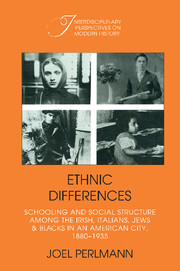 Ethnic Differences
Ethnic Differences 1 - Background: The City, Schooling, and Social Structure
Published online by Cambridge University Press: 05 October 2010
Summary
Providence and its schools
Providence had been one of colonial America's earliest settlements; by the time of the Revolution it had also become one of the larger settlements. The town functioned then as a commercial center for the surrounding agricultural region and as a relatively important port. However, the real growth of Providence came with the industrialization of Rhode Island in the early nineteenth century. The city evolved into the commercial and financial center for the textile-mill towns of northern Rhode Island. Moreover, the city's own industries played an important part of the region's transformation.
Providence's industries were varied. Textiles never dominated there to the extent that they did in the nearby mill towns. Cotton mills and especially woolen mills were indeed numerous in the city and, by the late nineteenth century, large. However, by that time Providence was also the national center for the production of inexpensive jewelry. A jewelry firm could be started with a relatively small investment, and scores were. A related industry, the manufacture of silver and gold products, also involved some small firms, but these were overshadowed by one giant, the nationally known Gorham plant. The manufacture of base-metal products also captured major shares of industrial capital and labor. Several giant firms dominated the foundries and machine shops: the Nicholson File Company, the American Screw Company, Browne and Sharpe's machine-tool factory, and the Corliss steam-engine works.
- Type
- Chapter
- Information
- Ethnic DifferencesSchooling and Social Structure among the Irish, Italians, Jews, and Blacks in an American City, 1880–1935, pp. 13 - 42Publisher: Cambridge University PressPrint publication year: 1988
